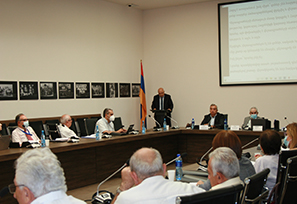
The three-day conference, organized by the Armenian Genocide Museum-Institute Foundation, the National Academy of Sciences, Yerevan State University and the Society for Armenian Studies (SAS)
“At the Crossroads of the Armenian Genocide, the Armenian Claims and the Artsakh Issue: Retrospective Evaluations and Prospects” was launched at the Conference Hall of Armenian Genocide Museum-Institute today.
The opening ceremony was followed by the opening of a temporary exhibition, which is thematically the first of its kind and has a special purpose, titled
"Tracing Armenian Claims: Ownership Certificates Relating to Individual and Community-Owned Armenian Assets" and was organised by the Armenian Genocide Museum-Institute Foundation and the National Archives of Armenia.
The opening speeches concerning it were delivered by Director of Armenian Genocide Museum-Institute Foundation Dr. Harutyun Marutyan and Director of the National Archive of Armenia, Grigor Arshakyan.
In his speech, the AGMI Director mentioned that
“This exhibition is unique, as it is the first time that only two dozen of the tens of thousands of documents proving the ownership of private and community property belonging to Armenians are being used to address the Armenian claims in general through a museum exhibition. The Armenian claims are a complex and multifaceted phenomenon; it is impossible to touch upon all their aspects with one small exhibition.”
Director of National Archive of Armenia Grigor Arshakyan emphasized the theme of the exhibition and stressed that there are hundreds of similar documents in the National Archives of Armenia, which are a strong basis for Armenian claims.
Seda Parsamyan, Head of the AGMI Department of Museum Exhibitions, said:
“The ownership deeds presented here are a very small part of similar documents preserved to this day. There are, to date, thousands of private, community estate documents which are kept in the archives of various institutions in Armenia and in the diaspora, as well as in museums and libraries and held by individual citizens which need to be catalogued and studied.”
The exhibition has bilingual notes. It contains about two dozen original Ottoman deeds and ownership documents which are displayed for the first time.
The exhibition is presented in five sections which reflect:
1. The essence of the Armenian claims, showing their formation and stages
2. Abandoned property laws and their legal development throughout the 20th century, that is, not only in the Ottoman Empire, but also in its continuing state, the Republic Turkey, until the 21st century
3. Compensation claims submitted by the Armenian delegation to the Paris Peace Conference in 1919-1920
4. The documentary bases of the Armenian claims - individual citizens’ certificates and those of community property ownership
5. The “limits” of the Armenian claims - the positions of the state/authorities, analytical centres, political forces as well as non-governmental organisations.
Some of the property deeds are documents showing the ownership of private property of Ottoman Armenian citizens: houses, gardens, fields, meadows, mills, factories and photo studios. Others are documents concerning the ownership of Armenian community estates, monasteries and churches. Although most of these institutions simply do not exist today, the documents presented testify to their former existence and Armenian affiliation.
It is known that in parallel with the massacres and deportations organized during the Armenian Genocide, the Turkish government carried out the forcible appropriation of Armenians' private property as well as community-owned estates. This was despite assurances from the Turkish government to the Armenians that it was taking steps to protect their property rights in order to adequately compensate them. But in reality, Armenian property was sold, auctioned and/or transferred to Muslim immigrants. The situation did not change during the latter years of the Ottoman Empire and its successor, the Republic of Turkey. The Ottoman government adopted a number of laws and decrees in order to justify its illegal actions and to prevent possible future claims.
Both domestic and international law recognise the right to adequate compensation in the event of alienation of individual property. From the Armenian claim point of view, these deeds are very important legal documents. They are usually issued by the estate official or the estate department and bear the personal seals of the various sultans of the Ottoman Empire. The documents presented, which date from 1872 to 1912/13, are factual evidence of the private and community property of the Armenian citizens and communities of the Ottoman Empire.
The exhibition will be open until April 2022.





